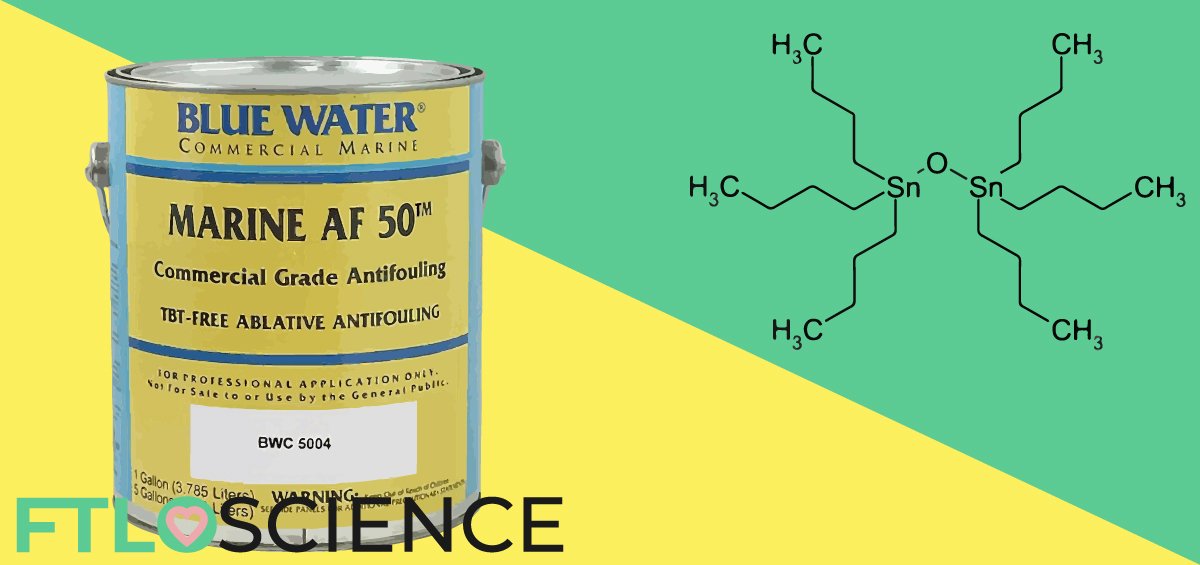A long-standing area of research is that of stannanes, also known as organotin compounds. First discovered almost 200 years ago, they continue to be relevant in industry and academia today. Although the mono- and tetra- substituted derivatives of tin are relatively non-toxic, di- and especially tri- organotin compounds are extremely toxic and can have serious adverse effects on the human body as well as the environment. This has been well-studied in the case of tributyltin, an anti-fouling agent that has since been banned.
Organotin Compounds
‘Organic bodies of tin’, as they were known when they came to light in 1852, were first described by British chemist Edward Frankland1. He reacted tin foil with ethyl iodide under heat to obtain crystals of dethyltin diiodide via:
Sn + 2C2H5I → (C2H5)2SnI2
These dialkyl diiodide tin compounds were important in their contribution to the advancement of metal valence theory, but otherwise had no particular practical use.
The popularity of organotin compounds in modern industry and organic chemistry came about after the discovery of Grignard reagents. Tin chloride could react to produce tetraorganotin compounds (four alkyl groups attached to a tin center):
SnCl4 + 4RMgX → 4 R4Sn + 4 MgXCl
(Where R denotes an alkyl group and X denotes a halogen)
The synthesized tetraorganotin compounds could then be further modified to the mono- or tri-substituted derivatives via the following redistribution reactions, opening up a whole new world of organotin possibilities:
R4Sn + 3 SnCl4 → 4 RSnCl3
R4Sn + R2SnCl4 → 2 R3SnCl3
These organotin compounds found widespread use, They acted as stabilizers, catalysts and biocides, in the process breaking barriers that once separated organic and inorganic chemistry.
Biofilm Formation and Tributyltin
One family of organotin compounds known as tributyltins were efficient biocides, able to kill fungi, bacteria and other living tissue. This was especially useful to the marine industry due to the inconvenience of biofouling.
Bio-fouling is the buildup of aquatic life (plants, algae, even animals) on structural surfaces, weakening the integrity of anchors and supports. Furthermore, the mass of buildup also increases friction and drag, which meant less efficient fuel use.
It was found that adding a little tributyltin to the paints used on the hulls of marine vessels greatly reduced the amount of biofouling that occurred.

Why Does Biofouling Occur?
Once a ship is lowered into the sea, organic molecules tend to adsorb onto its surface due to its hydrophobicity. Ships’ hulls are usually made of hydrophobic material; you don’t want water getting INSIDE your ship, after all.
Once a layer of organic material forms, microorganisms have a surface on which they can latch, subsequently secreting extracellular polymeric substances (EPS). EPS is essentially ‘construction material’ for bacterial settlements, providing them with additional structural support and protection2.

Tributyltin Enters the Marine Industry
The resulting mass of microorganisms is known as a biofilm, a rigid and stable structure. The difficulty in physically removing biofilm from the surface of ships meant there was a need for simple, cost-effective antifouling agents that could prevent its formation in the first place.
In a huge industry where antifouling agents were speculated to save billions of dollars a year in extra fuel and maintenance costs, attention turned to organotin compounds – already known for their biocidal properties.
For this purpose, special paints impregnated with tributyltin (TBT) compounds were formulated and proved to be extremely effective in that regard, becoming the most used antifouling method worldwide throughout the 1960s3.

Health Concerns for Organotin Compounds
Impact on Aquatic Life
TBT has a dual-action role; it prevents the settling of microorganisms on the surface of materials while poisoning those that somehow manage to. Despite its successes, however, TBT was later discovered to be unsafe for the environment, something which was overlooked during its introduction.
It turned out that the leeching of TBT from the paints into the ocean occurred at a slow rate, with far-reaching toxic effects that persists for decades. Disruption of sex hormones was shown to be common in many marine invertebrates exposed, with populations skewed to favor one gender over the other and affecting their reproduction.
Its effects were similar to another organic heavy metal, tetraethyllead, which was widely used as an antiknocking agent in petrol throughout the mid-1900s.
Bio-Accumulation
Bio-accumulation is a key feature of TBT due to its long half-life and stability, which in turn leads to toxic effects in vertebrates such as fish and even humans! The immune systems of otters exposed to TBT have been studied extensively, with research showing a positive correlation between TBT levels and the rate of infections4.
Along with its immunosuppressive effects, studies also showed that TBT might have potentially teratogenic effects – meaning that it affects unborn embryos and fetuses. Japanese rice fish embryos slowed in overall development rate as the TBT levels in their water increased. Exposure also increased the risk of deformities; many fish had tails bent at the tip, curled, and/or shortened5.
After almost 30 years in use, the first bans on TBT finally came about in 1998. This belated action was perhaps due to their efficacy and commercial success, with the marine industry especially reluctant to give up its use. In 2008, the use of organotin compounds was finally banned, unless used in the presence of an outer layer that ensured no leeching would occur.
Due to the long half-life of TBT compounds, they are predicted to remain in the water and sedimentary rock for 20 years from their release6. While there is still little data to support organotin toxicity in humans, the evidence from nature makes for a strong case. Bio-accumulation and the long-term adverse effects observed in fish embryos are especially dire warning signs.
Reference
- Nicholson, J. W. (1989). The early history of organotin chemistry. Journal of Chemical Education, 66(8), 621.
- Flemming, H. C., Wingender, J., Griebe, T., & Mayer, C. (2000). Physico-chemical properties of biofilms. Biofilms: recent advances in their study and control, 19-34.
- Konstantinou, I. K. (Ed.). (2006). Antifouling paint biocides(Vol. 5). Springer Science & Business Media.
- Kannan, K., Guruge, K. S., Thomas, N. J., Tanabe, S., & Giesy, J. P. (1998). Butyltin residues in southern sea otters (Enhydra lutris nereis) found dead along California coastal waters. Environmental Science & Technology, 32(9), 1169-1175.
- Antizar-Ladislao, B. (2008). Environmental levels, toxicity and human exposure to tributyltin (TBT)-contaminated marine environment. A review. Environment international, 34(2), 292-308.
- Antizar-Ladislao, B. (2008). Environmental levels, toxicity and human exposure to tributyltin (TBT)-contaminated marine environment. A review. Environment international, 34(2), 292-308.
About the Author

Sean is a consultant for clients in the pharmaceutical industry and is an associate lecturer at La Trobe University, where unfortunate undergrads are subject to his ramblings on chemistry and pharmacology.




